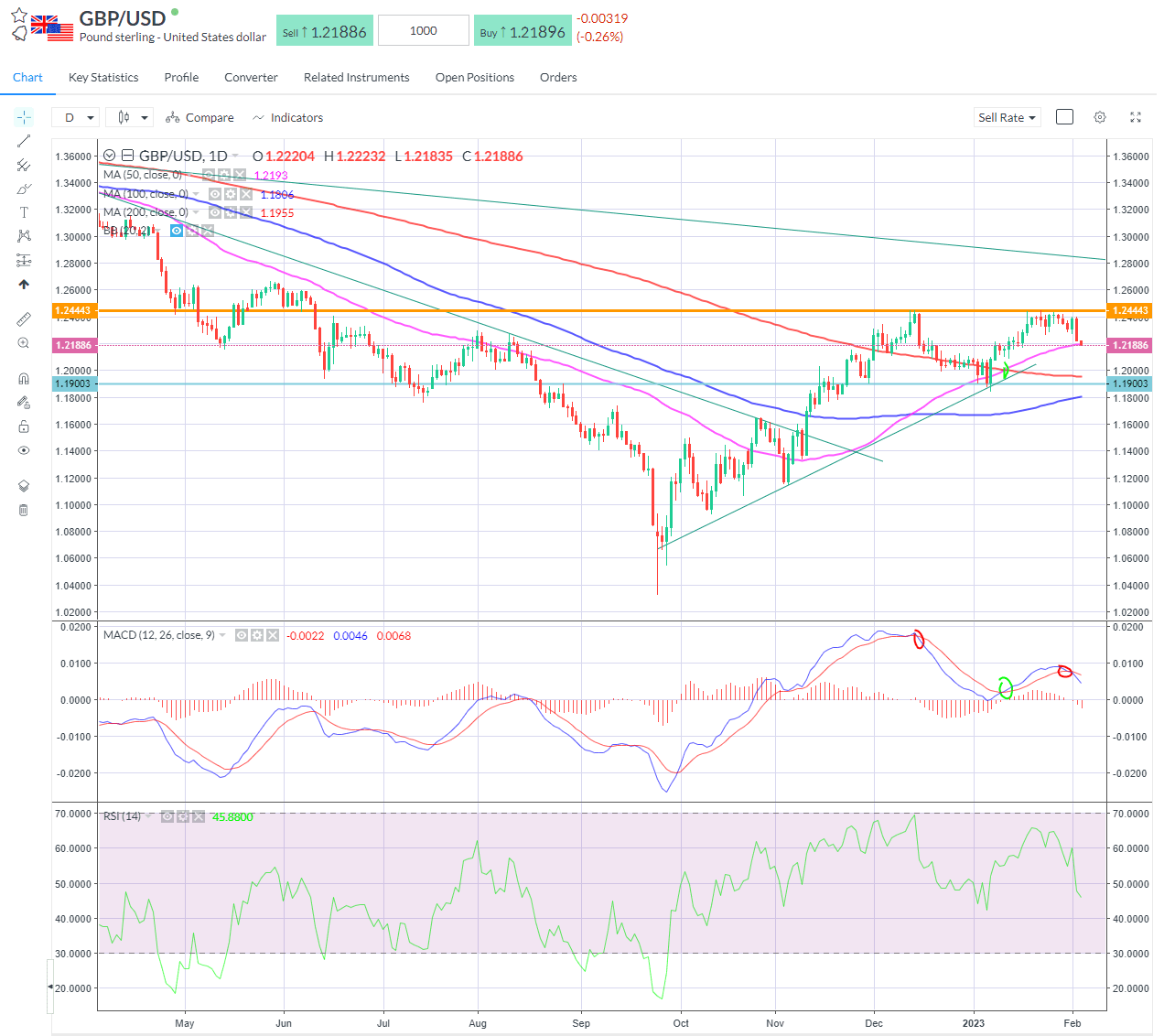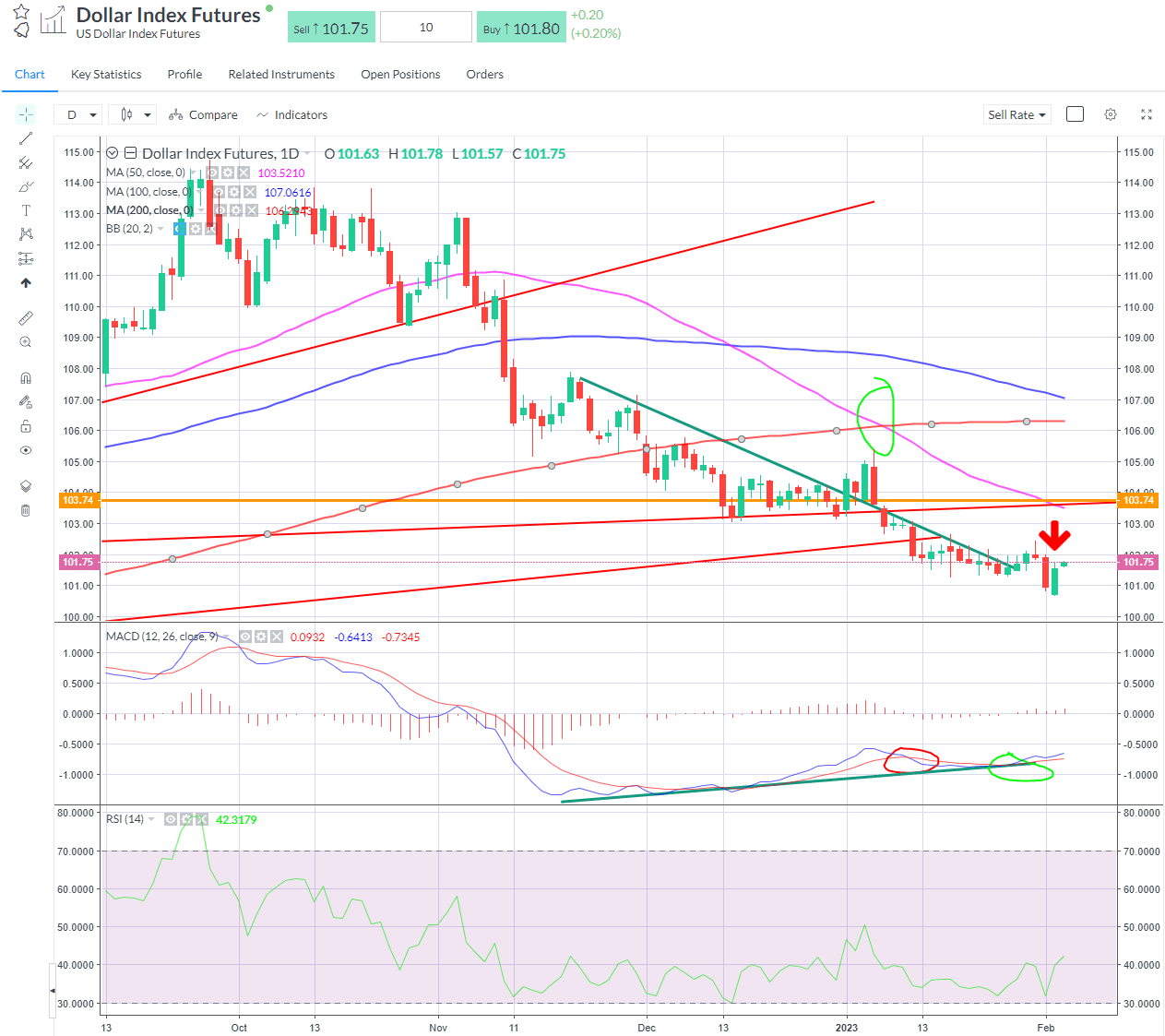
Friday Feb 3 2023 08:41

11 min
Europe Stocks Slip after Soft US Earnings, Rate Concerns
Stocks in Europe fell in early trading as the clutch of soft earnings update from the US pricked some of yesterday’s giddy optimism that rates are close to peaking. The FTSE 100, not one to get swept up in a FOMO frenzy, is steady but shares in Frankfurt and Paris are about 0.6-0.8% weaker in early trading after a huge run up for US tech the day before. That jolt higher for tech was led by hopes the Fed was near its peak and by a huge rally for Meta shares. Higher beta stocks did well on a day that does not tell me the bottom is already in. It’s a push-me pull-me on earnings and peak rate bets.
Trio of Tech Titans Trip Up in Earnings
Apple posted a decline in quarterly revenues for first time in almost four years, citing the strong dollar, production issues in China and the overall macro environment. Sales declined by 5% in the key holiday quarter, with earnings per share falling by more than 10%. Sales of iPhones declined 8%, whilst the biggest declines were in Mac and iPads, which each declined by around 30%. Solid performance at Other products and Services (+8% and +6% respectively) pointed to the resilience of the installed user base and longevity of its ecosystem. There were bright spots. Apple revealed it has 2bn active devices – up from 1.8bn a year before, and the company said the production issues were now fixed. Shares fell over 3% in after-hours trading. This was a very weak report from Apple and it’s hard to see how they can blame it all on external factors like the dollar and China’s lockdowns hitting production. There is clearly a demand problem here as consumers dial back spend.
Alphabet shares also declined more than 4% after it reported only the second quarterly contraction in advertising sales as advertisers cut spending and competition continues to intensify. The stock had gained about 7% in normal trading as the Nasdaq soared more than 3% with the lead from Meta, which jumped 23% after beating earnings expectations the day before. Cloud growth at Alphabet remained strong, up 32% to $7.32bn, though this was less than expected. Operating expenses rose 10% to $22.50 billion.
Amazon shares also declined in the after-hours trading as its cloud business suffered a slowdown. Amazon Web Services sales growth declined to 20% - still healthy by most standards – but down from 40% a year earlier. Overall net sales rose 9% in the final quarter to $142.2bn. The problem for Amazon in these results is that AWS has been the prime driver of profits. Operating margins fell to 1.8% from 2.5% a year before, whilst operating income declined to $.27bn from $3.5bn in the same quarter a year ago.
Market FOMO All Over
There is a strong smell of FOMO in this market – many of us didn’t think it should have rallied – or at least that it’s a bear market rally ready to fall to earth. So when it starts to grind up in a more deliberate manner, people incrementally start joining in – you wouldn’t want to miss out now if the bottom really was last year. The Fed’s wishy-washy, we don’t care about a bubble, it’s all going to be fine, financial conditions are easing narrative has only fuelled this further...for now it’s far from a slow grind higher. Yesterday’s huge jump in the Nasdaq on hot air – followed by disappointing earnings from the tech giants – underscore that there is still a huge amount of uncertainty and disagreement about where this market sits right now. But that is why it’s a market.
STIFEL: “Our forecast for an S&P 500 rally to 4,300 by spring 2023 is largely unchanged ... We foresee sharply lower inflation, a Fed pause in 2Q23, no recognizable 1H23 recession (or EPS recession) and improved global dollar liquidity ... risk likely rises in 2H23; the (overly) telegraphed slowdown may coalesce around mid-2023 ... and although we see inflation falling through 3Q23 the inflation rate may turn up again (i.e., oil, China) late this year, which would alarm the Fed.”
Yesterday DJIA -0.1%, NDX +3.25%...rotation out of cyclical/value into growth on Fed outlook continues....seems kind of odd but if you think Fed pauses and recessions hit, and the Fed starts cutting, then people want to pay for growth again, but they are missing it is ‘stagflationary’.
Meanwhile...investors are not convinced that this is THE bull transition says BofA with approx. $5tn in cash in money market funds ready to be deployed.
In short, markets seem giddy about rates getting close to peak but the earnings last night’s earnings underscored the headwinds this year for equities. And markets still think the CBs will be easier than they will be.
BoE Hikes
The Bank of England raised rates, and markets now think there is a higher chance of bank rate peaking at 4.25% than 4.5%...markets bet that it is close to the peak and sterling retreated sharply.
The Bank of England raised rates by 50bps, as expected, and signalled that it would tighten further if inflation pressures persist – and added that the risks are to the upside. But it also lowered the estimates for medium term wage growth, which hints that the Bank thinks it’s near the peak. Just like the Fed, we’re back to data-dependence.
The MPC voted to raise its benchmark rate from 3.5% to 4%, a 14-year high. With inflation at a 40-year high and stubbornly not coming down as fast as anyone would like, the BoE had little choice at this meeting. The MPC was split 7-2 on the decision.
On inflation, the BoE says risks are skewed significantly to the upside but thinks inflation has peaked; sees inflation at 3% in one year.
Wages are not seen racing higher and should stop sterling from extending gains. In fact we see the Bank reducing its wage growth estimate to +2.25% in Q4 ‘24, from +2.75% forecast in November; down to +1.5% in Q4 ‘25 from 2% three months ago.
On growth, the BoE sees shorter, shallower recession than it did in November – decent upgrades to the forecasts as was anticipated thanks to lower energy costs and lower market rates.
GBPUSD – tests key support on the 50-day line. As noted in our preview, longer term moves in sterling are less about the front end and the immediate decision to hike, but whether the BoE starts to shift its medium-term inflation outlook on rising wages and more persistent price pressures.

Central Banks Central to the Current Market
The ECB raised rates by 50bps and said it expects to raise them further, albeit in slightly less hawkish tones than it said in Dec. The ECB pre-committed to a 50bps in hike in March but gave markets the signal that that hike could be the last. “The Governing Council intends to raise interest rates by another 50 basis points at its next monetary policy meeting in March and it will then evaluate the subsequent path of its monetary policy.” The euro retreated to under $1.09. However, the view is that despite this signal it may pause after, the ECB remains the most hawkish of the three right now.
The main thing we can gather from this week’s central bank rate hikes and commentary is that they are data dependent now. I feel this means central banks will be hiking more than they and the market think as inflation will persist for longer – before stated structural problems in the labour market, the easing in financial conditions. The Fed didn’t quite take a premature victory lap but you could see Powell limbering up for it – too soon I feel.
DXY – strong piercing pattern – short-term reversal indicator., supports the MACD divergence.

